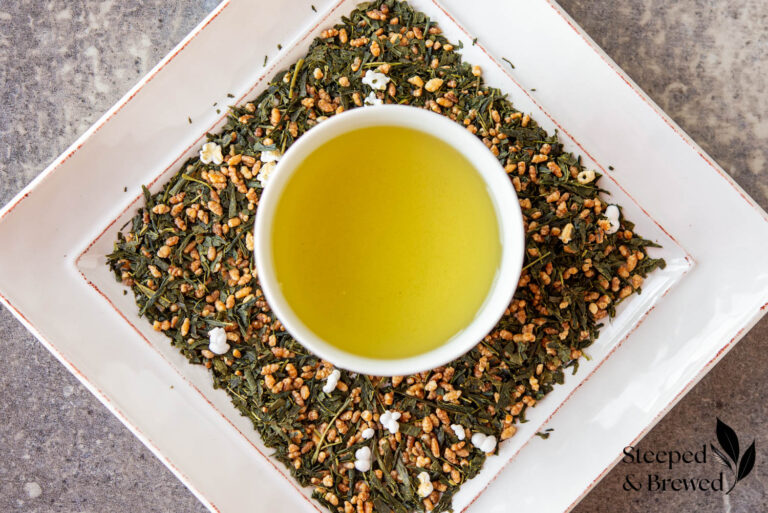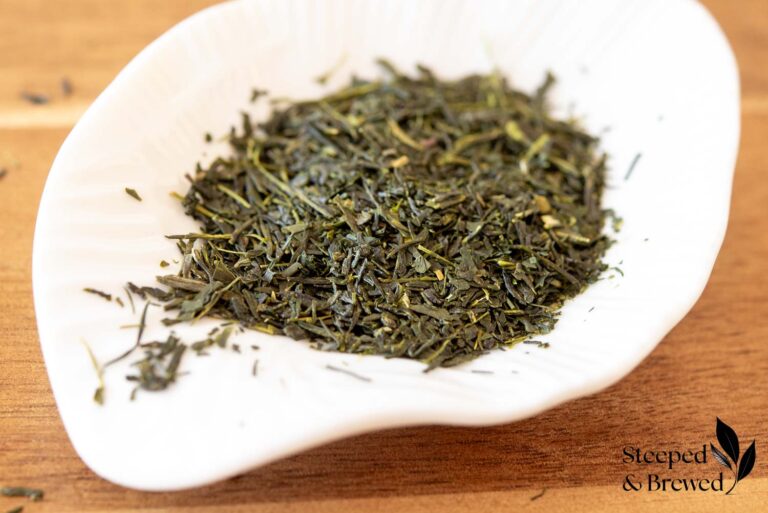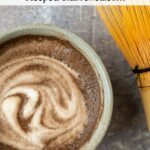This post may contain affiliate links. That means if you click on a link and make a purchase, I may make a small commission at no additional cost to you. Thank you for your support!
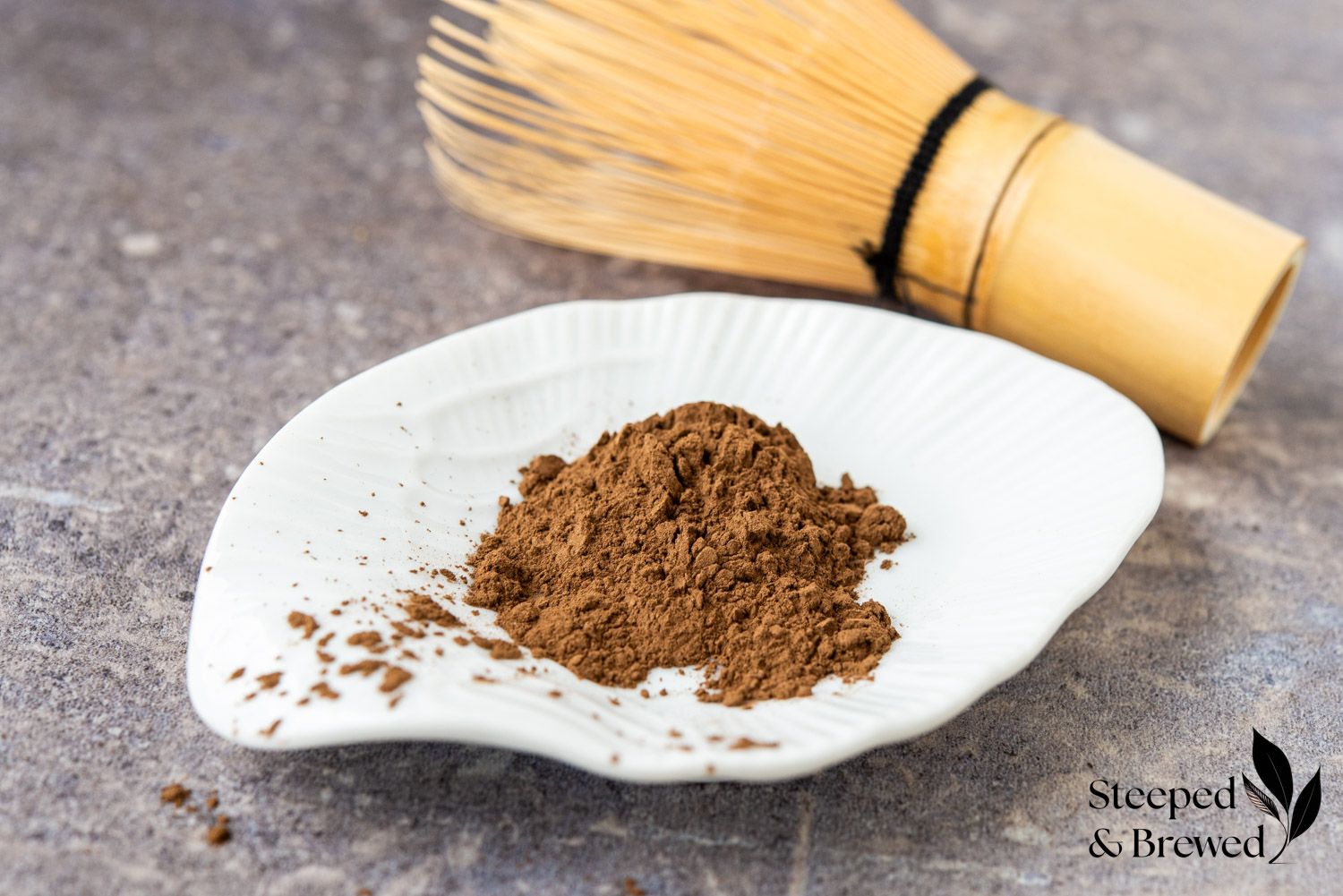

Ready for something a little different? Have you heard of hojicha powder, a type of roasted and ground green tea? As a dedicated black tea drinker, I had no idea that such unique and intriguing teas existed. Wow, was I missing out! I stumbled upon hojicha while researching matcha lattes and discovered that hojicha lattes are a delicious, lower-caffeine alternative. Curious, I ordered a bag of the cocoa-brown powdered tea from my friends at Nio Teas, and I’ve been enjoying many cups ever since!
About Hojicha Green Tea and Hojicha Powder
Hojicha is a type of roasted green tea with toasty and nutty flavors that hint at cocoa powder, coffee, and smoke. It is available as both a loose leaf tea and as a powder. Loose leaf hojicha can be brewed like any loose leaf tea, producing a roasty and full-bodied cup. Hojicha powder, which we are focusing on in this article, is exactly what it sounds like – hojicha tea that has been ground to a fine powder, perfect for whisking into a hojicha tea latte. Let’s learn some more…
It is the roasting process that sets this Japanese green tea apart. Unlike traditional green teas such as matcha and sencha, which retain their vibrant green color and grassy flavor, hojicha is roasted over high heat. This process gives hojicha its characteristic brown color and distinct, toasty flavor. Hojicha powder, sometimes labeled as ground hojicha, looks similar to cocoa powder and is made by finely grinding roasted tea leaves. This powder can be used to make tea lattes or added to various recipes for a unique twist.
Hojicha Aroma and Flavor Profile
Hojicha powder offers a surprisingly rich and complex flavor profile. The aroma draws you in with smoky and earthy notes, reminiscent of cocoa powder. The taste is predominantly roasted and nutty, with a slight sweetness that balances the smokiness. There is also a subtle hint of cooked vegetables, a common characteristic in other Japanese green teas. This might sound like an odd combination of flavors, but it works! The roasting process removes the typical bitterness of green tea, resulting in a smooth and enjoyable taste experience.
How is Hojicha Powder Produced?
The journey of hojicha begins with green tea leaves, typically bancha or sencha, along with stems and twigs of the tea plant. These parts are roasted at high temperatures, which reduces their caffeine content and imparts the tea’s signature roasted flavor. After roasting, the leaves, stems, and twigs are cooled and then ground into a fine powder. This roasting process not only changes the color and flavor of the tea but also decreases its astringency, making it more appealing for those who find traditional green teas too bitter.
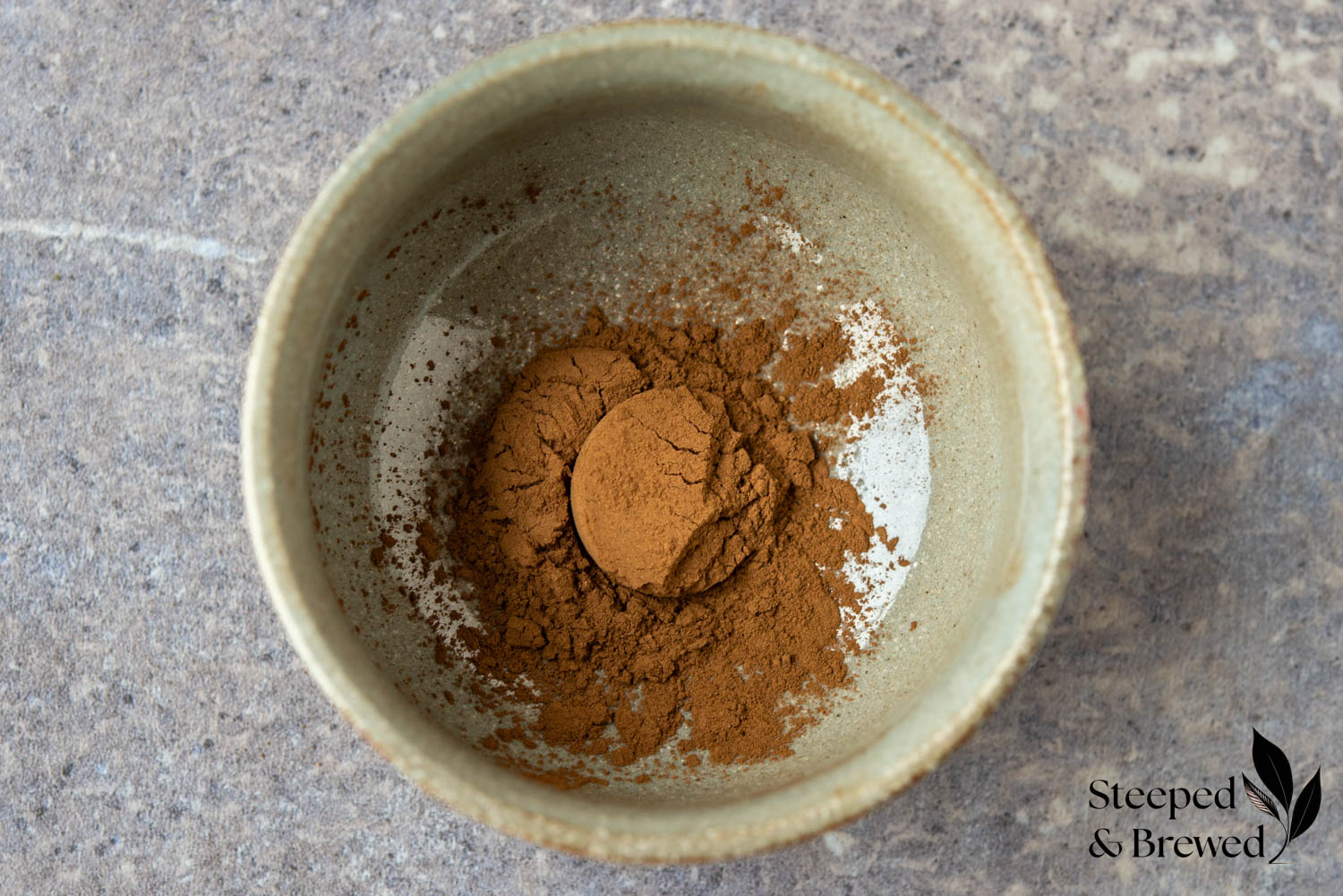

A Brief History of Hojicha
Hojicha originated in Japan in the 1920s, when a tea merchant in Kyoto sought to find a use for leftover tea leaves and stems. During this time, the youngest sprouts of the tea plant were reserved for premium teas, leaving older leaves with limited options for use. In a stroke of innovation, the merchant discovered that by roasting these older leaves, they produced a delightful flavor and aroma. This discovery marked the birth of hojicha.
Similar to other Japanese teas like genmaicha and kukicha, hojicha began as a way to maximize the tea harvest. Like so many “poor man’s meals” or money-saving food innovations, the resulting product quickly gained popularity, with its warm, comforting flavors captivating tea drinkers.
As hojicha’s popularity grew, so did the methods of preparing it. Over time, producers began experimenting with grinding roasted hojicha leaves into a fine powder. This powdered form of hojicha provided a new way to enjoy the tea, allowing it to be whisked into milk to create a smooth, frothy beverage. The versatility of hojicha powder quickly caught on, and it became a favorite ingredient not only for drinking but also for use in various culinary applications.
Whether enjoyed hot or cold, in its traditional leaf form or as a powder, hojicha’s distinctive roasted profile continues to charm tea enthusiasts, and its humble beginnings as a way to make the most of the tea harvest have only added to its enduring appeal.
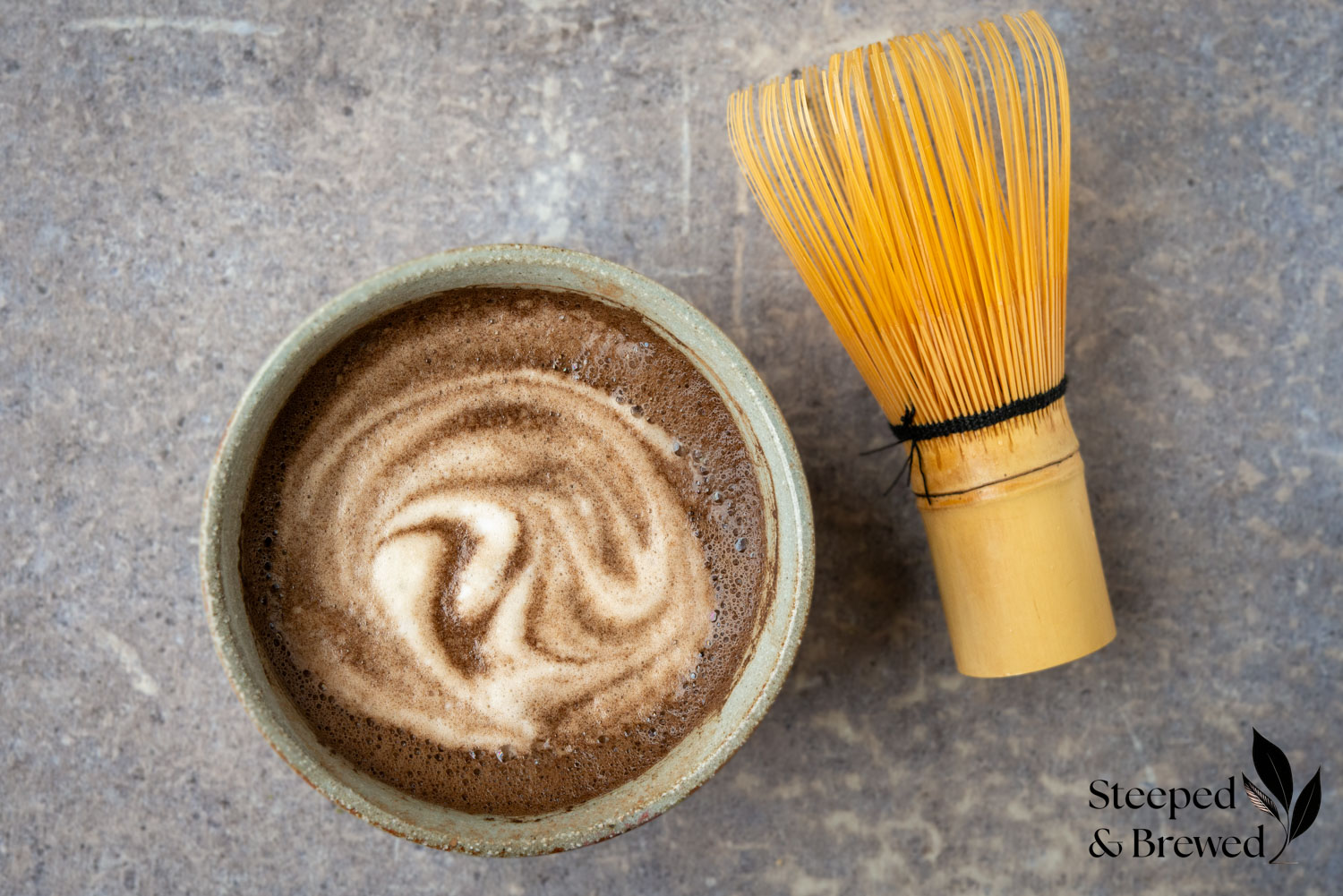

Culinary Uses for Hojicha Powder
Hojicha powder is not just for drinking; it can also be incorporated into various recipes. Its unique flavor makes it a wonderful addition to desserts and baked goods. You can use it to make hojicha-flavored ice cream, cookies, and cakes. In Japan, hojicha is often used in sweets, and its popularity is growing globally.
Check out a few recipes from my favorite hojicha powder producer, Nio Teas…
Hojicha Cookies
From the recipe author, “If you’ve ever felt that normal sugar cookies are a bit bland, you may want to spice things up a bit with Hojicha Cookies! This is a Japanese-inspired twist on a classic treat, using roasted tea powder for flavoring.”
Hojicha Pudding
From the recipe author, “In this article, we are going to follow a step-by-step recipe to make hojicha tea pudding, a delicious treat that can either be a mid-day snack, or a decadent dessert.”
Hojicha Cake
From the recipe author, “If you’re looking to try something new and exotic for that next birthday party, the hojicha cake is just for you! This combines the delicious flavor of hojicha with everyone’s favorite dessert! In this recipe, we’ll show you how to prepare, bake and garnish a hojicha cake that is worthy of a celebration. Let’s get cooking! 🎂”
What is a Hojicha Latte?
A hojicha latte is a cozy and comforting beverage made by blending roasted hojicha tea powder with milk. Unlike traditional green tea lattes, which are made with matcha, hojicha lattes offer a unique flavor profile characterized by toasty, nutty, and slightly smoky notes. The roasting process reduces the caffeine content, making it a perfect choice for those looking for a mellow, yet flavorful, tea experience.
In recent years, hojicha lattes have gained popularity both in Japan and internationally. Their rich, warm flavors and lower caffeine content make them an appealing alternative to coffee or more traditional tea lattes. Whether enjoyed hot or cold, hojicha lattes provide a tasty way to savor the depth of roasted green tea, making them a favorite among tea enthusiasts and newcomers alike.
Rich & Robust Hojicha Latte Recipe
I prefer my beverages to be punchy and bold, and I’ve found that many hojicha latte recipes are too mild for my taste. Most recipes call for about 1 teaspoon of hojicha powder to about 1 cup of liquid, usually a mix of water and milk. For me, this results in a drink that feels more like lightly flavored milk. To achieve a richer, more robust flavor, I use 1 teaspoon of hojicha powder with about 1/2 cup of liquid. This ratio creates a latte with a stronger, more satisfying taste, perfect for those who enjoy their tea on the bolder side.
What do you think? Do you like a richer, bolder hojicha latte, or are you a fan of the more lightly flavored versions? Also, if you have any recipe tips or suggestions, please share! After all, I am new to the hojicha world and would love to hear about your experiences. Feel free to share your thoughts in the comments section below!
Print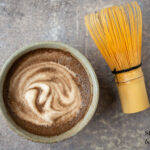

Rich & Robust Hojicha Latte: Perfect for Bold Flavor Lovers
- Total Time: 5 minutes
- Yield: One small latte, about 1/2 cup
Description
Indulge in the perfect blend of roasty, bold flavors and creamy yumminess with this rich and robust hojicha latte recipe. It’s a cozy cup of toasty goodness, where the deep, nutty notes of roasted green tea meet the rich creaminess of warm milk. Whether you’re looking for a soothing morning pick-me-up or a relaxing evening treat, this hojicha latte is sure to hit the spot.
Ingredients
- 2 grams (about 1 teaspoon) hojicha powder
- A splash of hot water at around 175°F (80°C) – enough to make a paste, about 2 teaspoons or 10 ml
- 100 ml (a scant 1/2 cup) milk of your choice (see notes), heated to your desired temperature
- Sweetener to taste (optional – maple syrup would be a tasty choice)
Instructions
- Add the hojicha powder to a small mixing or drinking bowl, such as a chawan matcha bowl.
- Add a small amount of hot water, just enough to make a paste, and whisk until frothy. This is easiest with a bamboo chasen whisk, the type you would use to make matcha. If you don’t have a bamboo whisk, a small kitchen whisk or a handheld milk frother will work, although you may have trouble breaking up any clumps. Sifting the hojicha powder before adding it to the bowl may help prevent clumping.
- If you’d like, use a milk frother to froth the milk, and then combine the frothed milk, hojicha powder paste, and sweetener to your taste. If you don’t have a milk frother, you can create a light and pleasant foam on top by vigorously whisking the hojicha paste and milk together using a bamboo whisk. Enjoy!
Notes
Many people recommend oat milk for hojicha lattes. Use whatever you like. In my kitchen, it’s whole cow’s milk all the way!
I prefer my beverages to be punchy and bold, and I’ve found that many hojicha latte recipes are too mild for my taste. Most recipes call for about 1 teaspoon of hojicha powder to about 1 cup of liquid, usually a mix of water and milk. For me, this results in a drink that feels more like lightly flavored milk. To achieve a richer, more robust flavor, I use 1 teaspoon of hojicha powder with about 1/2 cup of liquid. This ratio creates a latte with a stronger, more satisfying taste, perfect for those who enjoy their tea on the bolder side.
- Prep Time: 5 minutes
What’s in my cup…
Frequently Asked Questions
Is hojicha powder prepared without milk any good?
In my opinion, it’s just okay. Without the creamy texture of milk, the flavor can be reminiscent of instant coffee, and the powder tends to settle at the bottom rather quickly. When it comes to hojicha powder, I recommend sticking with hojicha lattes for the best experience. If you prefer hojicha brewed like traditional tea, loose leaf hojicha is a better choice.
Why is the hojicha powder settling into a sludge at the bottom of my cup?
Great question! Hojicha powder is finely ground roasted tea leaves, and unlike loose leaf tea, which is steeped to extract flavor, or instant coffee, which dissolves in water, hojicha powder is whisked directly into the liquid, similar to matcha. If you sip your hojicha latte slowly, the powder may settle at the bottom over time. To prevent this, whisk it vigorously into the milk until frothy, and swirl your cup frequently as you drink.


